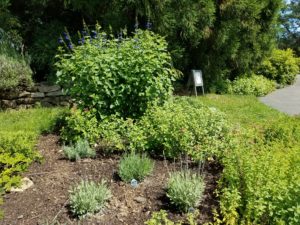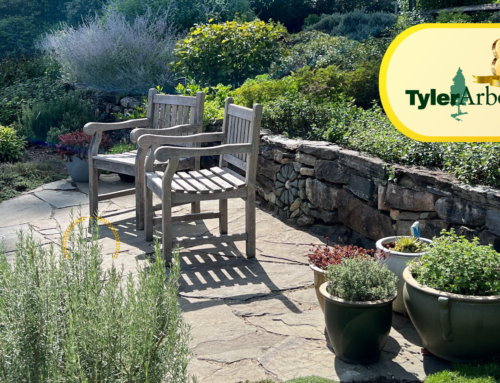 Lavender, a member of the mint family, is a perennial herb popular for its purple flowers and wonderful scent. A native of the Mediterranean, lavender (Lavendula) has been used for thousands of years. It is mentioned in the Bible several times (in the Bible it is called spikenard or nard) and legend has it that Cleopatra used its sweet aroma to entice Antony and Julius Cesar. Egyptians used lavender in funerals to help the dead to heaven. When Howard Carter opened King Tutankhamun’s tomb, the dried lavender flowers still held their scent.
Lavender, a member of the mint family, is a perennial herb popular for its purple flowers and wonderful scent. A native of the Mediterranean, lavender (Lavendula) has been used for thousands of years. It is mentioned in the Bible several times (in the Bible it is called spikenard or nard) and legend has it that Cleopatra used its sweet aroma to entice Antony and Julius Cesar. Egyptians used lavender in funerals to help the dead to heaven. When Howard Carter opened King Tutankhamun’s tomb, the dried lavender flowers still held their scent.
In addition to its aroma, lavender is prized for its antiseptic and anti-inflammatory properties. Its oils can be used to treat sunburn, insect bites, cuts and acne. Putting some of the oil on one’s temples can ease tension and migraine headaches. Soldiers carried lavender to treat burns from Roman times until as recently as World War I. The essential oils are widely used in aromatherapy to promote calmness and as a sleep aid.
Lavender buds which have a floral and slightly sweet taste are used to flavor desserts and beverages. Although it is not a native plant, lavender attracts pollinators and repels mosquitoes.
I recently spoke with Rena Barnett, past chair of the Philadelphia division of the American Herb Society and chair of Tyler’s Horticultural committee, about growing lavender. Rena said lavender prefers sandy, well-drained soils and 6-8 hours of full sun. When first planted, water one or twice a week. After that, watering once every three weeks should be fine. Plants should be mulched with light-colored pebbles, gravel, or crushed oyster shells.
Which type and variety?
Tyler currently has two pots of lavender angustifolia “Silver Mound” in the Edible Garden. In the Fragrant Garden there are a few different kinds of lavender. One plant – Lavendula x intermedia ‘Grosso’ is thirty-five years old. There is also a specimen of Lavendula x intermedia ‘Provence’ which has  fewer smaller flowers but has a more intense scent. Lavendula x intermedia are hybrids between English and Portuguese species and are hardier than French lavenders. These hybrids tend to be larger and more robust than the French. French lavender, Lavendula stoechas will bloom and rebloom but is not recommended for our planting zone and should be treated as an annual. Gardeners in our area are most successful with English lavender, particularly, Lavendula angustifolia ‘Phenomenal.’
fewer smaller flowers but has a more intense scent. Lavendula x intermedia are hybrids between English and Portuguese species and are hardier than French lavenders. These hybrids tend to be larger and more robust than the French. French lavender, Lavendula stoechas will bloom and rebloom but is not recommended for our planting zone and should be treated as an annual. Gardeners in our area are most successful with English lavender, particularly, Lavendula angustifolia ‘Phenomenal.’
One of the best sources for lavender, and other herbs, is the annual plant sale conducted by the American Herb Society-Philadelphia unit. Unfortunately, like Tyler’s plant sale, this sale has been postponed. Rena recommended Wedgewood Garden which has plants for sale online and Black Creek Greenhouse in Lancaster. Due to overwhelming demand, Black Creek is not offering curbside pickup.
Growing Lavender
Rena recommends buying lavender plants rather than starting plants by seed if you want true to form plants. As lavender ages, it gets woody. Because of that, many gardeners replace their lavender plants every 3—4 years. When purchasing a plant, be sure that it has a good root system. To encourage strong root growth in new plants, Rena suggests that gardeners cut off the flowers. Lavender should be dead headed during the summer and the dead growth cut back in the spring.
To dry lavender for in use sachets and potpourri, cut the lavender to the ground and hang upside down, leaving space between branches for air circulation. When it is dry, rub the flowers off. For a pleasant scent in fireplaces, the dried sticks can be used as fire starters.
I have not had much success with lavender in the past but with the recommendations from Rena, I intend to try again. Beautiful flowers, wonderful scent, attracts pollinators and repels mosquitoes. Lavender sounds like the perfect addition to any garden.






